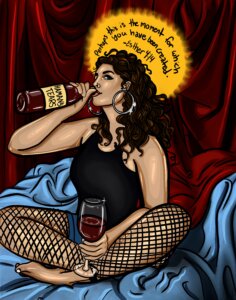(Jewish Group) How a Black, queer, Jewish artist uses her work to change the world
Long before the U.S. Supreme Court overturned Roe v. Wade, Ayeola Omolara Kaplan was thinking about how to illustrate the need to protect reproductive rights.
Finally, the image for what would become “Abortion Justice is a Jewish Value” came. A garland of flowers interspersed with Hebrew and English text surrounds several women. They are Black, white and brown. They have caramel curls and mermaid-green tresses. One wears a Star of David, another a hamsa.
“There are moments where I feel really upset about abortion rights being taken away, and the idea that there are more rights that they could take away. I feel a stronger sense of urgency than ever before to create and act. That’s how I view my role as an artist; as pushing back,” Kaplan, a digital artist, said about the piece. The work was commissioned by the National Council of Jewish Women. Proceeds will go to organizations that provide abortion access and health care.
At 24, Kaplan, a Black, Jewish and queer artist, is making a career out of creating pieces that explore identity, class and spirituality. Whether she is depicting the idea of reparations as a form of teshuva (repentance) or imagining Queen Vashti and Queen Esther as rulers over a realm devoid of misogyny, Kaplan sees her art as a means of self-defense in a world that can feel fractured and fraught.

In “Esther,” the queen drinks from a bottle labeled “Haman’s Tears” while wearing a sleek black tank top, denim shorts over fishnet stockings, and sparkling silver hoops. The words “perhaps this is the moment for which you have been created,” from the Book of Esther float above her dark brown hair.
more...
